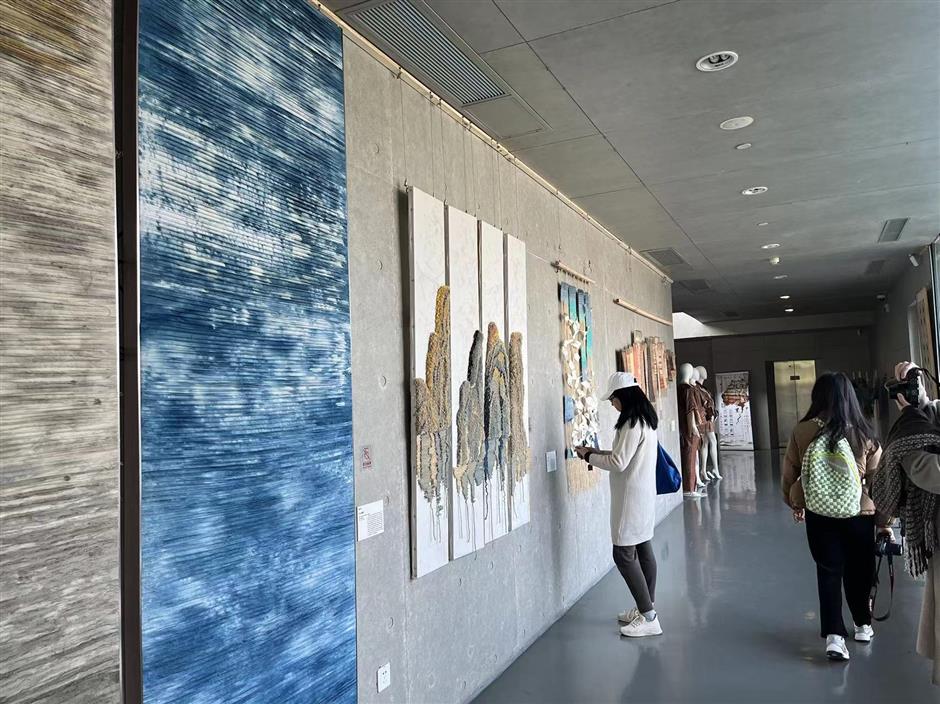Discover history of natural dyes at biennale
Have you ever wondered how ancient people dyed their fabrics? You will find the answers at the China National Silk Museum, which is hosting the 3rd Natural Dyes Biennale.
"The study of natural dyestuffs is significant in both ancient and modern history," said Ji Xiaofen, the museum's curator. "As the social focus shifts to environmental protection, people are becoming more interested in natural dyeing technologies."
"We have researched and gathered the plants and dyeing techniques from around the world that show the wisdom and ingenuity of different nationalities."
The biennale comprises two exhibitions: "Colors of Nations" and "The Sources of Colors."
The "Colors of Nations" exhibition, which runs through November 28, features 100 works produced by 80 artists from 10 countries. This section introduces influences from nature.
Nature's wonders have inspired countless concepts and fashion expressions. Designers and fabric makers have always taken note of unusual plants and animals to create vivid designs through embroidery, printing, and other techniques.
Domestic designers Zhang Hanmin, Zhang Tao and Hong Caixia dyed cotton fabrics in varying shades of blue and beige with tea, red soil, persimmon juice, banlangen (a plant often used in traditional Chinese medicine), and walnut husk before rolling them into an image of grandmother. The cotton fabrics were made from industrial waste.

A collage of dyed cotton by designers Zhang Hanmin, Zhang Tao and Hong Caixia
An 83-year-old Bai ethnic woman who has spent over 70 years weaving and dyeing inspired the grandma image. The designers learned her dyeing skills, which make extensive use of natural materials, from the hamlet where she lives.
This work depicts the concept of sustainable development and the harmonious relationship between humans and nature.
The Bai is one of China's 55 minority tribes that have practiced dyeing for millennia. Authentic Bai dyeing consists of six basic steps, 30 production techniques, and about 1,000 patterns. It is widely used in everyday life as well as at rituals, festivals and ceremonies.
The details of the designs were depicted in a specific and delicate manner as textile printing and dyeing technology advanced. Artists are trying to revive centuries-old traditions by redesigning them.
Li Xinyuan, another Chinese designer, printed the xiangyun gauze (a traditional silk fabric) with a natural pigment called shugeng (a variety of yams) and created a picture reminiscent of Song Dynasty (960–1279) ink-wash art. The gauze was dyed into various shades of brown and shaped into the undulating hills found in old paintings.
The xiangyun gauze is known as "soft gold" in the family of silk due to its lengthy manufacturing process, high price and limited production.

A dyed silk painting by Li Xinyuan
The other exhibition "The Sources of Colors" will be on display until February 25. Professionals examined the museum's artifacts from the 4th to the 15th centuries and discovered 20 natural dyeing materials.
Although natural dyes diminished as chemical synthetic dye manufacturing emerged, their glorious days cannot be forgotten.
Chinese indigo and banlangen were used to extract indigotin (indigo dyes), which were then utilized to create various naval hues. The most frequent color comes from modern-day Zhejiang and Fujian provinces, where artisans continue to produce naturally dyed cottons today.
Artisans commonly dyed yellow hues millennia ago. To create five various shades, artisans changed the proportions of native plants such as huangbo, huaizi, and huanglu. Today, artisans rarely use such natural dyestuffs.
In Chinese culture, red has traditionally been considered an auspicious color. Throughout the dynasties, royal courts preferred crimson and scarlet silks colored with kermes.
In the mid-16th century, Spaniards learned that the American cochineal, a parasitic insect that lives primarily in cactus, was widely employed as a source of dye in South America. It was later introduced to China and utilized as a pigment during the Qing Dynasty (1644–1911).
The black fabrics on display were stained with tannin-rich botanicals. Three centuries ago, people commonly used the bark and leaves of oaks, Sicilian sumac and Chinese sumac.

The two exhibitions at the China National Silk Museum examine natural dyeing technologies through the history.
Colors of Nations
Date: Through November 28, closed on Mondays.
Admission: Free
The Sources of Colors
Date: Through February 25, closed on Mondays
Admission: Free
Address: 73-1 Yuhuangshan Rd
玉皇山路73-1
















